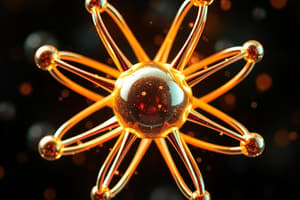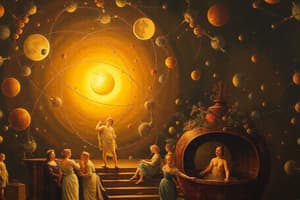Podcast
Questions and Answers
What fundamental idea did John Dalton contribute to atomic theory?
What fundamental idea did John Dalton contribute to atomic theory?
- Atoms have a spherical shape.
- Atoms are made up of positive and negative charges.
- Atoms can be divided into smaller particles.
- All objects are composed of indivisible particles called atoms. (correct)
Which statement about Democritus’s concept of atoms is true?
Which statement about Democritus’s concept of atoms is true?
- Atoms are the smallest units that matter can be divided into.
- All materials are fluid and can change shape.
- Atoms are made up of electrons and protons.
- Atoms can exist in isolation. (correct)
In J.J. Thomson's model, which part of the atom contains negative charge?
In J.J. Thomson's model, which part of the atom contains negative charge?
- The nucleus
- The spherical jelly
- The electrons (correct)
- The atomic mass unit
What was J.J. Thomson's model of the atom called?
What was J.J. Thomson's model of the atom called?
What does Rutherford's atomic model propose about the structure of the atom?
What does Rutherford's atomic model propose about the structure of the atom?
What misconception might be drawn from John Dalton's atomic theory?
What misconception might be drawn from John Dalton's atomic theory?
Which statement accurately describes Niels Bohr's contribution to atomic theory?
Which statement accurately describes Niels Bohr's contribution to atomic theory?
What is the primary concept of Schrödinger's quantum-wave model?
What is the primary concept of Schrödinger's quantum-wave model?
What did James Chadwick contribute to atomic theory?
What did James Chadwick contribute to atomic theory?
Which law states that the total mass of substances remains constant during a chemical reaction?
Which law states that the total mass of substances remains constant during a chemical reaction?
What is a key postulate of Dalton's Atomic Theory regarding compounds?
What is a key postulate of Dalton's Atomic Theory regarding compounds?
Which atomic model is best associated with the idea of electrons existing in fixed circular orbits?
Which atomic model is best associated with the idea of electrons existing in fixed circular orbits?
What does the Law of Definite Proportions state?
What does the Law of Definite Proportions state?
What does the wave function Ψ represent in quantum theory?
What does the wave function Ψ represent in quantum theory?
Which quantum number describes the distance between the nucleus and the electron shell?
Which quantum number describes the distance between the nucleus and the electron shell?
How many neutrons does an atom of carbon-14 contain?
How many neutrons does an atom of carbon-14 contain?
What is the maximum number of electrons that can be accommodated in the fourth shell?
What is the maximum number of electrons that can be accommodated in the fourth shell?
What is the total number of nucleons in an atom of sodium-23?
What is the total number of nucleons in an atom of sodium-23?
Which of the following correctly represents the change in the electron count when sodium becomes a cation?
Which of the following correctly represents the change in the electron count when sodium becomes a cation?
Which of the following statements about the principal quantum number (n) is true?
Which of the following statements about the principal quantum number (n) is true?
For the element iron-19, how many protons are present?
For the element iron-19, how many protons are present?
How many quantum numbers are required to completely describe the state of an electron?
How many quantum numbers are required to completely describe the state of an electron?
What is the number of electrons in the anion form of iron when it gains one electron?
What is the number of electrons in the anion form of iron when it gains one electron?
What characterizes an atomic orbital?
What characterizes an atomic orbital?
Which of the following describes the behavior of electrons as the principal quantum number increases?
Which of the following describes the behavior of electrons as the principal quantum number increases?
If an atom of carbon has 6 protons, how many electrons does it have when it is neutral?
If an atom of carbon has 6 protons, how many electrons does it have when it is neutral?
Understanding the electron density or probability density, Ψ^2, is crucial for which aspect of wave functions?
Understanding the electron density or probability density, Ψ^2, is crucial for which aspect of wave functions?
What is the atomic mass of sodium given its isotopic composition?
What is the atomic mass of sodium given its isotopic composition?
In the notation for an ion, what does a negative charge represent?
In the notation for an ion, what does a negative charge represent?
How many neutrons would an atom of gold with an atomic mass of 197 have?
How many neutrons would an atom of gold with an atomic mass of 197 have?
When discussing isotopes, which description is accurate?
When discussing isotopes, which description is accurate?
Which atomic model emphasizes that most of an atom's volume is an empty space?
Which atomic model emphasizes that most of an atom's volume is an empty space?
What was the primary conclusion from Rutherford's α Scattering Experiment?
What was the primary conclusion from Rutherford's α Scattering Experiment?
What distinguishes the nucleus of an atom as described in the nuclear model?
What distinguishes the nucleus of an atom as described in the nuclear model?
Why did most alpha particles pass through the gold foil unscattered in Rutherford's experiment?
Why did most alpha particles pass through the gold foil unscattered in Rutherford's experiment?
What neutral particle was discovered by James Chadwick?
What neutral particle was discovered by James Chadwick?
What model of the atom did Thomson propose based on his discoveries?
What model of the atom did Thomson propose based on his discoveries?
What does the Law of Multiple Proportions state about the masses of B that combine with a given mass of A?
What does the Law of Multiple Proportions state about the masses of B that combine with a given mass of A?
What was J.J. Thomson's significant contribution to atomic theory?
What was J.J. Thomson's significant contribution to atomic theory?
Flashcards are hidden until you start studying
Study Notes
Development of Atomic Theory
- Democritus (600 BC) proposed the existence of atomos – fundamental indivisible particles.
- John Dalton (1803) proposed the solid sphere model, stating that all matter is composed of atoms – indivisible solid spheres. His postulates included the Law of Constant Composition, the Law of Conservation of Mass, and the Law of Multiple Proportions.
- J.J. Thomson (1897) discovered the electron through his cathode ray tube experiments, leading to the plum pudding model, where electrons were embedded in a positively charged sphere.
- Ernest Rutherford (1911) conducted the alpha scattering experiment, revealing the nuclear model: a small, dense, positively charged nucleus surrounded by mostly empty space containing orbiting electrons.
- Niels Bohr (1913) proposed the planetary model, where electrons orbit the nucleus in specific energy levels or shells.
- Erwin Schrödinger (1926) developed the quantum-wave model, describing electrons as matter waves and introducing wave functions (Ψ) to describe electron behavior.
- James Chadwick (1932) discovered the neutron, a neutral particle residing in the nucleus.
Atomic Structure and Subatomic Particles
- Atoms contain protons (+ charge), neutrons (neutral charge), and electrons (- charge).
- The nucleus contains protons and neutrons; most of the atom’s mass is concentrated here.
- The atomic number (Z) equals the number of protons and defines the element.
- The mass number (A) equals the number of protons plus neutrons (nucleons).
- Isotopes are atoms of the same element with the same number of protons but different numbers of neutrons.
- Ions are formed when atoms gain or lose electrons, resulting in a net charge. Cations have a positive charge (electron loss), anions have a negative charge (electron gain).
Quantum Numbers and Atomic Orbitals
- Quantum numbers describe the state of an electron in an atom. Four quantum numbers are used.
- The principal quantum number (n) determines the electron shell and energy level (n = 1, 2, 3…); higher n means greater energy and distance from the nucleus. The maximum number of electrons in a shell is 2n².
- Wave functions (Ψ) describe the behavior and location probability of electrons, ψ² is the probability density (electron density).
- Atomic orbitals are regions of space where there's a high probability of finding an electron; each orbital is represented by a specific set of quantum numbers.
Mass of Atoms
- Atomic mass is the weighted average mass of an element’s isotopes, taking their relative abundances into account.
Studying That Suits You
Use AI to generate personalized quizzes and flashcards to suit your learning preferences.




